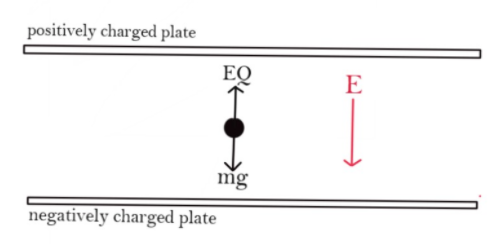Question
Question: A charged oil drop of mass \(2.5 \times {10^{ - 7}}kg\) is in space between two plates, each of area...
A charged oil drop of mass 2.5×10−7kg is in space between two plates, each of area 2×10−2m2 of a parallel plate capacitor. When the upper plate has a charge of 5×10−7C and the lower plate has equal negative charge then the oil remains stationary. The charge on the oil drop is (take,g=10m/s2)
a. 9×10−3C
b. 9×10−6C
c. 8.85×10−13C
d. 1.8×10−34C
Solution
The oil drop is stationary between the plates which means the net force on the oil drop is zero. The upward electrostatic force is balanced by downward force of gravity.
Step by step answer:
Following information is given in the question
Mass of oil drop, m=2.5×10−7kg
Area of parallel plates, A=2×10−2m2
Charge on oil drop,Q=5×10−7C
Now,
We know that Surface charge density,
λ=aQ
λ=2×10−2m25×10−7C
λ=2.5×10−5C/m2
We know that,
Electric field inside a parallel plate capacitor,E=ε0λ
Where,
ε0=permittivity of free space
E=8.85×10−122.5×10−5

Balancing forces on oil drop
Gravitational force = electrostatic force
mg=EQ
2.5×10−7×10=8.85×10−122.5×10−5×Q
Q=8.85×10−13C
Option C is the correct answer
Electric field given in the question is downwards as shown in the figure. So charge must be negatively charged in order to balance the force of gravity by applying electrostatic force in an upward direction.
Q=−8.85×10−13C
Additional information:
- This is a famous experiment known as the Millikan’s oil drop experiment. This experiment is performed by Robert A. Millikan to measure the electric charge of an electron.
- The goal of this experiment was to observe tiny charged droplets of oil between two horizontal electrodes. The only difference between this question and Millikan’s experiment is that the drops are not in rest in the original experiment. The droplets are allowed to fall freely between the electrode and terminal velocity is noted which is then used to calculate the electric charge of an electron.
- Millikan repeated this experiment number of times then he obtained various values of charge and is found to be a multiple of 1.6×10−19C
Note: Electric field produced by single plate is 2ε0λ but electric field inside the parallel plate capacitor is the sum of electric fields produced by both plates which is 2×2ε0λ=ε0λ.
